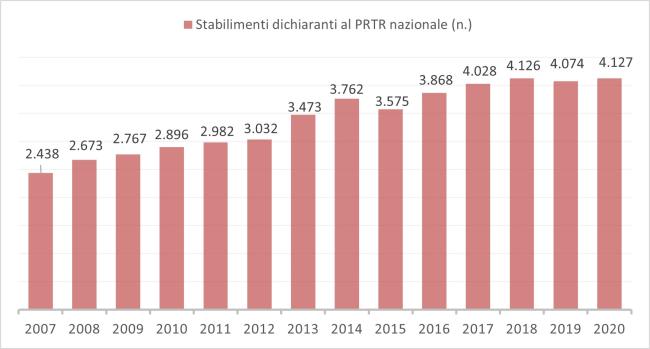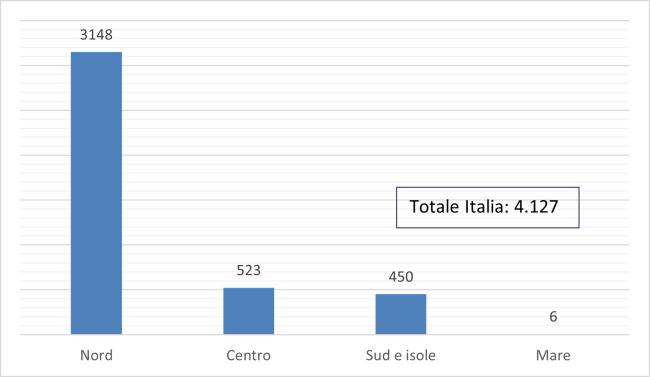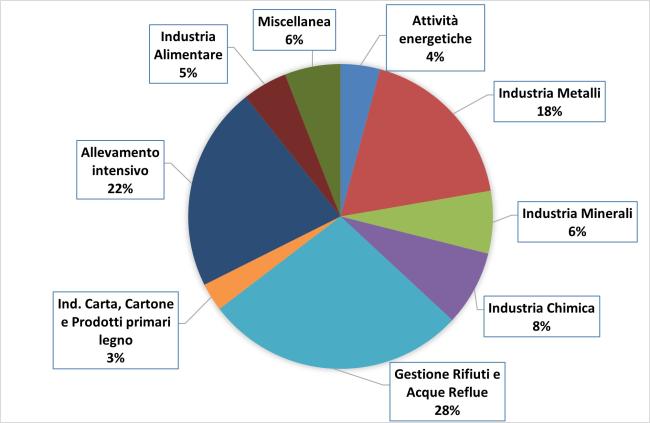Panel 1
Andrea Gagna
The European Pollutant Release and Transfer Register (EPRTR) is the integrated register established by the EU, based on Regulation (EC) No. 166/2006, with the aim of making available to the public information on the environmental impacts caused by industrial establishments that meet the criteria specified by the regulation. In 2020, the industrial sources responsible for most emissions to air and water were 4,127, of which 3,148 are located in the North, 523 in the Centre, 450 in the South and Islands, and 6 in the sea. The number of declared PRTR activities is 5,086. Generally, the total number of declared PRTR activities is always greater than the number of declarations received, as one establishment can carry out one or more PRTR activities.
The indicator represents the total number of industrial sources responsible for most emissions to air and water. The number and type of PRTR activities declared allows identification of the major activities and industrial processes generating emissions. The majority of reporting establishments fall under the activities listed in Annex VIII of Part II of Legislative Decree 152/2006 and subsequent amendments, making the indicator also representative of the contribution of so-called installations subject to Integrated Environmental Authorisation (AIA) (formerly IPPC). Information on the number of establishments and PRTR activities is collected through the PRTR declaration. According to the regulation, PRTR establishments with emissions to air, water, or wastewater exceeding certain threshold values, or with waste transfers exceeding threshold values, are required to submit a declaration. The number of declarations received by ISPRA corresponds to the number of establishments subject to PRTR declaration obligations (Regulation EC No. 166/2006, DPR 157/2011, and Article 30 of Legislative Decree 46/2014). In summary, the criteria include a threshold system based on: a list of activities (threshold values associated with production or treatment capacity); a list of substances to monitor with reference to air and water (specific emission thresholds for each pollutant and environmental matrix); the transfer of hazardous and non-hazardous waste (threshold for the quantity of hazardous and non-hazardous waste transferred).
The purpose is to quantify the reporting base of the national PRTR register. It describes the national distribution of PRTR establishments and identifies the most significant PRTR/IPPC activities, such as the sources of emissions or pollutant and waste transfers, that contribute the most to emissions and transfers resulting from industrial processes.
Regulation EC No. 126/2006; DPR No. 157/2011 and Article 30 of Legislative Decree 46/2014. The regulation (Regulation EC No. 166/2006, DPR No. 157/2011, and Article 30 of Legislative Decree 46/2014) requires the annual collection, through electronic means, of information related to the identification of reporting PRTR complexes, the PRTR activities performed, emissions to air, water, and soil, pollutant transfers to wastewater, and waste transfers. The national PRTR register is updated annually, and the regulation also provides for public access to the register and communication of the information to the European Commission for the annual update of the European Integrated Register EPRTR (European PRTR).
Panel 2
The data collection system for the PRTR registry, based on the self-declaration process by facilities and validation by the competent authorities, offers room for improvements aimed at further enhancing the completeness of the database. In-depth analysis of certain specific activities could lead to changes in the reporting base and the indicators associated with them. It is also possible that the same data quality evaluation procedures, carried out by the competent authorities, could result in further expansion of the reporting base for the PRTR Registry in the coming years.
Data quality assessment
ISPRA (Italian National Institute for Environmental Protection and Research)
The information related to the number and types of PRTR facilities on the national territory, as well as the impacts they generate (emissions and transfers), can be freely accessed on the EPRTR (European Pollutant Release and Transfer Register) website: https://industry.eea.europa.eu/#/home
National, Regional, Provincial
2007-2020
Indicator assessment
Aggregations and disaggregations by geographical parameters and PRTR codes.
The annual data collection cycles related to the INES register made it possible, in the past, to build a database covering over 700 facilities for the years 2002 to 2006. The evolution of European and national legislation, along with the establishment of the national PRTR register, has expanded the number of facilities subject to the PRTR reporting obligation and, consequently, the volume of available data. In 2020, the number of reporting facilities amounted to 4,127 (Table 1).
Over the years, it has been observed that only a few of the 45 PRTR categories are not represented in the Register’s data, specifically: installations for the manufacture of products based on coal and smokeless solid fuels; installations for asbestos production and manufacturing of asbestos-based products; installations for intensive aquaculture; installations for the construction, painting, or stripping of ships (shipyards).
The processes of data quality assessment and the growing awareness of this legal requirement have led not only to an improvement in the quality of the data reported but also to a further expansion of the reporting base for the PRTR register.
In 2020, the PRTR activities not covered in the register were limited to those listed above, with the exception of shipyard activity, which was reported by one facility. Regarding asbestos production, due to the national legal framework, no industrial facilities in Italy are expected to carry out this activity.
At the macro-geographical level, the PRTR reporting facilities are distributed as follows: 3,148 in Northern Italy, 523 in Central Italy, 450 in Southern Italy and the Islands, and 6 offshore (Table 1 and Figure 2). In terms of PRTR activity types, the facilities are primarily distributed as follows: 28% in waste and wastewater management (1,144 facilities), 18% in the metal industry (747), 22% in intensive livestock farming (896), and 8% in the chemical industry (329) (Table 2 and Figure 3).
The most recent information on PRTR facilities and activities was collected through the 2020 PRTR Declaration and therefore refers to the year 2020. As of 2020, the PRTR register database consists of information provided by over 4,000 facilities: the number of reporting facilities has steadily increased over the years, rising from 2,438 in 2007 to 4,127 in 2020 (Figure 1).
This increase over time can be attributed to the growing awareness of this legal obligation among potentially subject entities, which is partly the result of awareness-raising and information dissemination initiatives carried out by ISPRA in collaboration with trade associations and local competent authorities.
In 2020, the number of reported PRTR activities was 5,086. This figure also shows a consistent upward trend, having increased from 2,469 activities reported in 2007 (Table 2). Generally, the total number of PRTR activities exceeds the number of declarations received, as a single reporting facility may carry out one or more PRTR activities.
Data
Table 1: Reporting facilities by region and province in 2020
| ISPRA, National PRTR Register |
| The 'marine' label takes into account offshore platforms that have submitted their declaration to the PRTR register. |
| update at 31/08/2022 |
Table 2: Number of activities carried out at facilities by PRTR code, sector, and reference year.
| "ISPRA, National PRTR Register |
| The 2020 data are updated to the communication of 31/08/2022. |




The subsequent PRTR declaration collection cycles provide a data base that continues to grow year by year, potentially due to several contributing factors: increased awareness among Operators regarding the legal reporting obligation; better understanding of the criteria for inclusion in the PRTR register that underpin the declaration requirement; actions by competent authorities to assess data quality, along with the effects of inspections at facilities, which also include verification of compliance with this obligation.